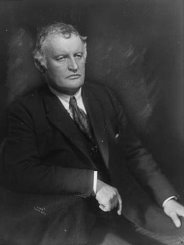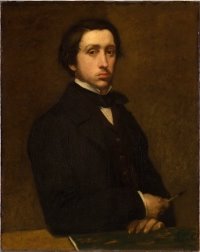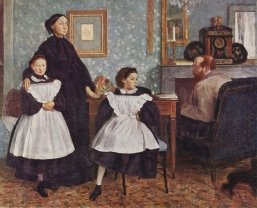Система уроків по темі «Мистецтво» з використанням проектних робіт
Запровадження інформаційно-комунікаційних технологій у навчально-виховний процес – це не данина моді, а необхідність сьогодення, оскільки більшість дітей ознайомлюються з комп'ютером набагато раніше, ніж це їм може запропонувати школа.
Актуальність даної проблеми полягає в тому, що організація вивчення англійської мови є неможливою без використання ІКТ на уроках англійської мови і, тим самим, ставить перед вчителями завдання їх активного використання, що забезпечує краще оволодіння учнями матеріалу.
Звернувшись до методу проектів з використанням мультимедійних технологій, я зрозуміла, що такий вид роботи (переважно в групах), метою якої є підготовка кінцевого продукту англійською мовою – альбому, подання інформації тощо, дає учню можливість виконати незалежну роботу, побудовану на знанні мови та уміннях і навичках, здобутих упродовж певного періоду вивчення теми. Проектні роботи ідеальні для різнорівневих груп, оскільки кожне завдання може бути виконане учнями, що мають різний рівень підготовки. У процесі проектної діяльності учні реально спілкуються між собою і з навколишнім світом англійською мовою. Практична мета виконання певної проектної роботи може базуватись на удосконаленні різних умінь та навичок. Деякі роботи вимагають більше практики усного мовлення, інші більше спрямовані на розвиток навичок письма, ще інші вимагають застосування певних артистичних здібностей. Досвід переконав, що якісь завдання більше підходять для індивідуальної роботи, інші - для роботи в парах або малих групах. Вдало підібрані завдання та методи його виконання дають можливість почуватися учням максимально комфортно.

англійської мови в 11 класі
за підручником
Л.В.Калініна, І.В.Самойлюкевич
«Your English Self»
з теми:
«Мистецтво»

Вчитель: :Железковська О.Ю.
Олександрівська ЗШ І-ІІІ ст. №1
Lesson 1
Topic: Art is Power
Type of the Lesson: combined
Objectives:
Practical: to present and practise expressions, to practise intensive reading, different genres and techniques; to practise listening for specific information;
Educational: to enlarge students’ knowledge about different genres and techniques in painting;
Developing: to develop students’ creative skills; to bring up students to love art.
Equipment: a textbook form 10-th Kalinina L.V., Samoiliukevych I.V., interactive board, handouts, a computer presentation, Internet.
Lesson structure
- Introduction to the Lesson.
- Greeting and Aim.
T: Look on the whiteboard and tell me what can you see there? (There are pictures of the famous artists). What is the topic of our lesson? (Students’ answers).
T: Yes, you are quite right. The topic of our lesson is “Art is Power”.
- Warm up.
- Make up an acrostic:
A
R
T
-
Pre-test and Engage Yourself: p.192
- Do you know much about different art styles and can you recognize them?
Yes __ No__
- Can you describe your favourite painting and speak about its artist?
Yes __ No__
- Have you ever visited a picture gallery or a museum of Fine Arts?
Yes __ No__
- Can you emphasize important points in art?
Yes __ No__
T: Welcome to more of it!
-
The Main Part of the Lesson.
- Vocabulary p.192
- T: Look through the words and find the meanings of them in your dictionaries.
Academic English
trend of art
to merge together
canvas
to be depicted in
transparent colours
sketch book
artistic phenomenon
easel painting
murals
art critic
![]() art admirer
art admirer
to develop a style of painting
art movement
Conversational English
…from the distance
to give way for feelings
to emphasize something
to give birth to something
discrepancies
skeetchy
to follow feelings and emotions
to stick to something
to be rich in something
to interept something
to reject something
In this connection …
In all likelihood…
art styles
- T: Make up 2-3 sentences with these expressions and write them into your copybooks.
-
T: Now read your sentences.
- Speaking Ex.I, p.193
-
T: Look at these works of art and say what you think of them and look at the presentation of different styles of painting on the interactive board.( Look at the presentation #1).
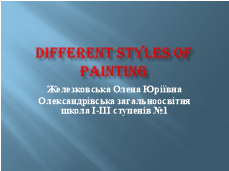
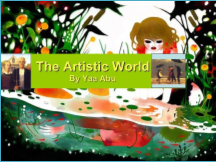 (Presentation #2)
(Presentation #2)
(Pupils’ answers)
P1: The Mona Lisa is the "most famous" in the world's eyes. I think that the Mona Lisa is slightly overrated (that's just my opinion).
P2: Famous like in having a widespread reputation? Or meaning first-rate, excellent? In the first meaning, yes indeed, it probably is the Mona Lisa. But sadly it doesn't evoke emotions as some other paintings do. It all seems to turn around that one question: "Why does she smile in that way?"
P3: The main features of the Cubism are: The use of elementary geometrical forms. So Sonia Delaunay, a cubist painter knows how to appreciate colour relationships, the influence of one colour on another, their contrasts and dissonances, is promised and infinitely diverse imagery.
P4: Why do people like Wassily Kandinsky's art? Mostly because it entertains them. Also, in school it takes less thought and more creativity, so more people choose it over math, science English etc.
- T: Now children read what great people said about art and practise sentence stress. Develop the idea of one of the quotes. Ex.II-III, p.193-194.
“When `one `loves `one’s art, no `service `seems `too hard.” (Oscar Wild)
“We `all `know that `art is `not truth. `Art is a `lie that `makes us `realise truth, at least the `truth that is `given us to understand.” (Pablo Picasso)
“Art is all but ‘imitation of nature.” (Seneca)
“’Art for ‘art’s sake.” (Howard Dietz)
- Grammar Revision
a) p.194-196 Indirect Speech
T: If you want to report what a speaker said without using the exact words, use indirect speech.
b) p.196-197 Reporting Words
T: To summarize what someone said, use reporting words with the following structures.
-
P.197 Activising Grammar material in exercices a), b), a), p.197-198 (Students are devided into 3 groups and every group does one of the exercises. After that one of the students from each group reads the right variant of the exercises).
- Relaxation.
T: Now, children listen to one joke and try to retell it.
(The teacher can use one of the jokes)
1. Two painters had been painting houses for over a year, and it was going too slow, and they were very frustrated. One day one of the painters came up to the other and said." You know, I’ve been thinking, we really haven't accomplished much in a year's work, and it's just going too darn slow. I have an idea. How about we thin our paint out with water, and that way it will go faster and farther. “Sounds like a good idea to me", said the other. So, they went on like this for another year or so, when one day one of the painters came to the other and said." I have been feeling very convicted about what we're doing, and I think we should repaint all the houses that we thinned out with water" "All the houses!” said the other. “Are you crazy?" Why the sudden conviction?" "Well", the painter replied. “Last night I was sleeping soundly, when all of a sudden I was awakened by this nine foot angel standing by the foot of my bed. I was so scared, I couldn't speak. But the angel, He pointed one giant finger at me and said, “Repaint you thinner, and go a thin no more."
2. An artist asked the gallery owner if there had been any interest in his paintings on display at that time.
"I have good news and bad news," the owner replied. "The good news is that a gentleman enquired about your work and wondered if it would appreciate in value after your death. When I told him it would, he bought all 15 of your paintings."
"That's wonderful," the artist exclaimed. "What's the bad news?"
"The guy was your doctor..."
3. An artist had been working on a nude portrait for a long time. Every day, he was up early and worked late - bringing perfection with every stroke of his paint brush. As each day passed, he gained a better understanding of the female body and was able to really make his paintings shine.
After a month, the artist had become very weary from this non-stop effort and decided to take it easy for the day. Since his model had already shown up, he suggested they merely have a glass of wine and talk - since normally he preferred to do his painting in silence.
They talked for a few hours, getting to know each other better. Then as they were sipping their claret, the artist heard a car arriving outside. He jumped up and said, "Oh no! It's my wife! Quick, take off your clothes!"
- A bumper sticker for artists: "My other car is a bike, too."
- There was this world famous painter. In this prime of her career, she started losing her eyesight. Fearful that she might lose her life as a painter, she went to see the best eye surgeon in the world.
After several weeks of delicate surgery and therapy, her eyesight was restored. The painter was so grateful that she decided to show her gratitude by repainting the doctor’s office.
6. Artist Pablo Picasso surprised a burglar at work in his new chateau. The intruder got away, but Picasso told the police he could do a rough sketch of what he looked like. On the basis of his drawing, the police arrested a mother superior, the minister of finance, a washing machine, and the Eiffel tower.
Artists do it by design.
Artists do it expressively.
Artists do it with creativity.
Artists do it with emotion.
Artists do it with flair.
Artists do it with longer strokes.
(The teacher can use Internet with video: <iframe width="640" height="360" src="http://www.youtube.com/embed/5vrc-8GHLcc?feature=player_embedded" frameborder="0" allowfullscreen></iframe>)
- Activising Grammar Material in exercises.
T: Open your books on page 198 and do exercise. Martha and Phil are taiking about their preeferences in art. Use the verbs in bold to report their conversation. Make up your own by anology.
-
The Conclusion of the Lesson.
- Homework.
T: Our lesson is finishing. And your homework will be to find more informaton about impressionist style of painting and present it to youre class. You can make your presentation using Microsoft Office PowerPoint.
- Summarizing. Marks.
T: Our lesson is over. But what have you learnt today? What was the most interesting for you? What was the most difficult? What was the easiest?
Lesson 2
Topic: From Old to New Art
Type of the Lesson: combined
Objectives:
Practical: to present and practise expressions, to practise intensive reading, to describe different genree and techniqes; to practise listening for specific information;
Educational: to enlarge students’ knowledge about different genres and techniques in painting;
Developing: to develop students’ cognitive and creative skills; to bring up students to love art.
Equipment: a textbook form 10-th Kalinina L.V., Samoiliukevych I.V., projector, interactive board, handouts, a computer presentation, Internet, pictures of famous painters.
Lesson structure
- Introduction to the Lesson.
- Greeting and Aim.
T: Good morning, students. I am sure you everybody admires art. We have already spoken about drama, music, cinema at our lessons. Today we are going to speak about art again. We’ll learn more about painting and check your knowledge.
- Warm up.
T: But first let’s do some activities. Do you want to be a painter? Let’s try to make a picture. (Teacher divides students into 3 teams and gives some pictures of different things, paper, glue and scissors). Try to make your own picture.
T: I see that you are real artists.
Check on Homework.
(Students prepared information about impressionist style of painting and present it to the class. Some of them show their presentations using Microsoft Office PowerPoint.)
-
The Main Part of the Lesson.
- Reading p.201 Text “From Old to New Art”
- Pre-Reading Activity
Substitution tables
- The painter’s goal is to view the life philosophically
was to pay attention to follies and vices of
the middle class
to raise the problems of the morals
- In his canvases the painter asserted the spiritual beauty of a man
pictures relied on his personal observations
portraits presented the essential modernity of his
vision
3.The artist was an outstanding potraitist
a creator of poetic symbol of his homeland
- While-Reading Activity
The students are divided into five teams. The students of the first team read the first paragraph, the students of the second team the second one, etc.
- Post-Reading Activity
Then the teams change their representatives and tell everything they remembered from the text.
- Relaxation.
T: Let’s have some rest and watch and listen to a wonderful song
Painters
Eighty years, an old lady now, sitting on the front porch
Watching the clouds roll by they remind her of her lover, how he left her
And of times long ago when she used color carelessly, painted his portrait
A thousand times - or maybe just his smile -
And she and her canvas would follow him wherever he would go
'cause they were painters, and they had painting themselves, a lovely world
Oil streaked daisies covered the living room wall
He put water colored roses in her hair
He said, 'love, I love you, I want to give you the mountains, the sunshine, the sunset too'
I just want to give you a world as beautiful as you are to me
'cause they were painters, and they had painting themselves, a lovely world
So they sat down and made a drawing of their love, they made it an art to live by
They painted every, passion every home, created every beautiful child
In the winter they were weavers of warmth, in the summer they were carpenters of love
They thought blue prints were too sad so they made them yellow
'cause they were painters, and they had painting themselves, a lovely world
Until one day the rain fell as thick as black oil
And in her heart she knew something was wrong
She went running through the orchard screaming
'no god, don't take him from me!'
But by the time she got there, she feared he already had gone
She got to where he lay, water colored roses in his hands for her
She threw them down screaming, 'damn you man, don't leave me
With nothing left behind but these cold paintings, these cold portraits
To remind me!'
He said, 'love I only leave, but only a little, try to understand
I put my soul in this life we've created with these four hands
Love, I leave, but only a little, this world holds me still
My body may die now, but these paintings are real'
So many seasons came and so many seasons went
And many times she saw her love's face watering the flowers
Talking to the trees and singing to his children
And when the wind blew, she knew he was listening
And how he seemed to laugh along, an how he seemed to hold her when she was crying
'cause they were painters, and they had painting themselves, a lovely world
Eighty years, an old lady now, sitting on the front porch
Watching the clouds roll by, they remind her of her lover, how he left her
And of times long ago when she used color carelessly, painted his portrait
A thousand times - or maybe just his smile -
And she and her canvas would follow him wherever he would go
Yes, she and her canvas still follow
'cause they were painters, and they had painting themselves, a lovely world
http://www.english-easy.info/songs/j/jewel/pieces-of-you-1995/painters.html#ixzz1e6TFG2XJ
- Writing Game “Secret thoughts of art”.
How to use the activity?
Before the lesson begins, number the art pictures and pin them up round the room. Ask the students to take a pen and to walk round the room either individually or in pairs. They should stop in front of each art picture and imagine the secret thoughts of the character, or one of the characters, in the picture. They should write them down, but without mentioning the number of the picture.
When they have finished, ask them to swap lists with another student/pair, and go round again, trying to match pictures and thoughts.
T: Now walk around to try to find the character whose secret thoughts they have just read.
-
The Conclusion of the Lesson.
- Homework.
T: Our lesson is over. And your homework will be to find more information about European famous painters, present it to your class. You can make your presentation using Microsoft Office PowerPoint.
- Summarizing. Marks.
T: Our lesson is over. What do you think about our today’s lesson? Did you enjoy something? Would you like to do it at our next lesson?
Lesson 3 Excursion-lesson
Topic: European famous painters
Type of the Lesson: combined
Objectives:
Practical: to present and practise expressions, to practise intensive reading, to describe different genree and techniqes; to practise listening for specific information;
Educational: to enlarge students’ knowledge about impressionism, expressionists’ art;
Developing: to develop students’ cognitive and creative skills; to bring up students to love art.
Equipment: a textbook form 10-th Kalinina L.V., Samoiliukevych I.V., interactive board, handouts, a computer presentation, Internet, pictures of Edvard Munch, Claude Monet, Edgar Degas. (Edvard Munch http://www.youtube.com/watch?v=r5uaB5MDe_8&feature=related ), music of Chaikovskyi, Motsart.
Edvard Munch
The Scream (1893)
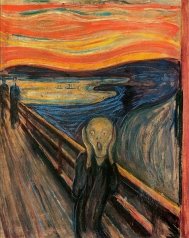 Painted in 1893, The Scream is Munch's most famous work and one of the most recognizable paintings in all art. It has been widely interpreted as representing the universal anxiety of modern man. Painted with broad bands of garish color and highly simplified forms, and employing a high viewpoint, the agonized figure is reduced to a garbed skull in the throes of an emotional crisis. With this painting, Munch met his stated goal of "the study of the soul, that is to say the study of my own self". Munch wrote of how the painting came to be: "I was walking down the road with two friends when the sun set; suddenly, the sky turned as red as blood. I stopped and leaned against the fence, feeling unspeakably tired. Tongues of fire and blood stretched over the bluish black fjord. My friends went on walking, while I lagged behind, shivering with fear. Then I heard the enormous, infinite scream of nature." He later described the personal anguish behind the painting, "for several years I was almost mad… You know my picture, 'The Scream?' I was stretched to the limit—nature was screaming in my blood… After that I gave up hope ever of being able to love again."
Painted in 1893, The Scream is Munch's most famous work and one of the most recognizable paintings in all art. It has been widely interpreted as representing the universal anxiety of modern man. Painted with broad bands of garish color and highly simplified forms, and employing a high viewpoint, the agonized figure is reduced to a garbed skull in the throes of an emotional crisis. With this painting, Munch met his stated goal of "the study of the soul, that is to say the study of my own self". Munch wrote of how the painting came to be: "I was walking down the road with two friends when the sun set; suddenly, the sky turned as red as blood. I stopped and leaned against the fence, feeling unspeakably tired. Tongues of fire and blood stretched over the bluish black fjord. My friends went on walking, while I lagged behind, shivering with fear. Then I heard the enormous, infinite scream of nature." He later described the personal anguish behind the painting, "for several years I was almost mad… You know my picture, 'The Scream?' I was stretched to the limit—nature was screaming in my blood… After that I gave up hope ever of being able to love again."
The Dance of Life. 1899–1900. Oil on canvas,
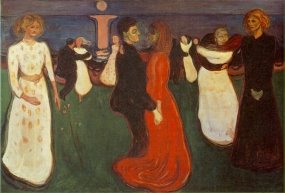 Munch returned to Christiania in 1897 where he also received grudging acceptance, where one critic wrote, "A fair number of these pictures have been exhibited before. In my opinion these improve on acquaintance." In 1899, at the age of thirty-four, Munch began an intimate relationship with Tulla Larsen, a "liberated" upper-class woman. They traveled to Italy together and upon returning, Munch began another fertile period in his art, which included landscapes and his final painting in "The Frieze of Life" series, The Dance of Life (1899).Larsen was eager for marriage, and Munch begged off. His drinking and poor health reinforced his fears, as he wrote in the third person, "Ever since he was a child he had hated marriage. His sick and nervous home had given him the feeling that he had no right to get married."
Munch returned to Christiania in 1897 where he also received grudging acceptance, where one critic wrote, "A fair number of these pictures have been exhibited before. In my opinion these improve on acquaintance." In 1899, at the age of thirty-four, Munch began an intimate relationship with Tulla Larsen, a "liberated" upper-class woman. They traveled to Italy together and upon returning, Munch began another fertile period in his art, which included landscapes and his final painting in "The Frieze of Life" series, The Dance of Life (1899).Larsen was eager for marriage, and Munch begged off. His drinking and poor health reinforced his fears, as he wrote in the third person, "Ever since he was a child he had hated marriage. His sick and nervous home had given him the feeling that he had no right to get married."
Self-portrait (Degas au porte-fusain), 1855
Portrait of the Bellelli Family, 1858–1867, Musée d'Orsay, Paris, France
Musicians in the Orchestra, 1872, oil on canvas, by Edgar Degas
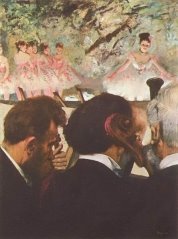 Blurring the distinction between portraiture and genre pieces, he painted his bassoonist friend, Désiré Dihau, in The Orchestra of the Opera (1868–69) as one of fourteen musicians in an orchestra pit, viewed as though by a member of the audience. Above the musicians can be seen only the legs and tutus of the dancers onstage, their figures cropped by the edge of the painting. Art historian Charles Stuckey has compared the viewpoint to that of a distracted spectator at a ballet, and says that "it is Degas' fascination with the depiction of movement, including the movement of a spectator's eyes as during a random glance, that is properly speaking 'Impressionist'."
Blurring the distinction between portraiture and genre pieces, he painted his bassoonist friend, Désiré Dihau, in The Orchestra of the Opera (1868–69) as one of fourteen musicians in an orchestra pit, viewed as though by a member of the audience. Above the musicians can be seen only the legs and tutus of the dancers onstage, their figures cropped by the edge of the painting. Art historian Charles Stuckey has compared the viewpoint to that of a distracted spectator at a ballet, and says that "it is Degas' fascination with the depiction of movement, including the movement of a spectator's eyes as during a random glance, that is properly speaking 'Impressionist'."
Claude Monet
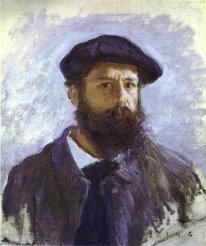
Farm Courtyard in Normandy. c.1863. Oil on canvas. Musée d'Orsay, Paris, France.
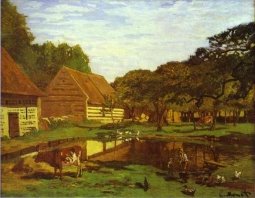
The London Harbour. 1871. Oil on canvas. Private collection, USA.
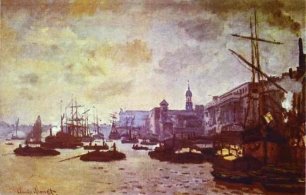
Camille Monet in the Garden. 1873. Oil on canvas. Private collection, Zurich, Switzerland.
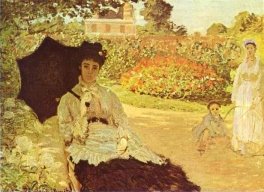
Autumn at Argenteuil. 1873. Oil on canvas. Courtauld Institute Galleries, London, UK.
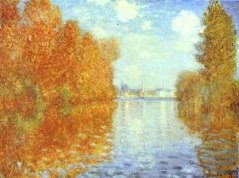
Madame Monet in Japanese Costume (La Japonaise). 1875. Oil on canvas. Museum of Fine Arts, Boston, MA, USA.
![]()
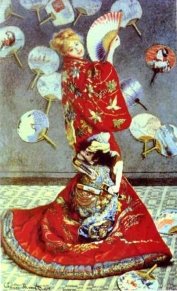
Vase with Flowers. 1880. Oil on canvas. Courtauld Institute Galleries, London, UK.
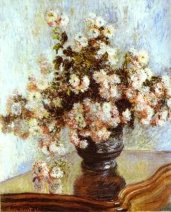
Storm, Coast at Belle-Ile. 1886. Oil on canvas. Musée d'Orsay, Paris, France.
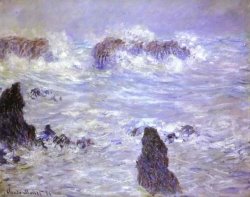
Young Girls in a Boat. 1887. Oil on canvas. National Museum of Western Art, Tokyo, Japan.
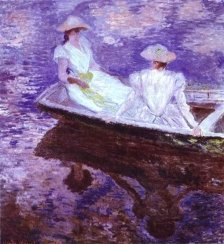
Lesson structure
- Introduction to the Lesson.
- Greeting and Aim.
T: Hello, dear children! First of all, I want you to look at the whiteboard and read these words. Please think what our lesson is devoted to. You can see some quotations about art. Read them.
“ A picture is a poem without words.” \Horace \
‘ A thing of beauty is a joy for ever,
Its loveliness increases; it will never pass into nothing.’
‘ Love art. Of all lies, it is the least untrue.’ \Gustave Flaubert\
T: How do you understand the words?
P1: I think that art makes people think about life, the beauty around them, nature, and love of their country and its people.
P2: In my opinion art wakes up people’s feelings, such as kindness, admiration, enjoyment, and peace in the soul.
T: Very well. What kinds of art can you name?
P3, 4: Architecture; Sculpture; Literature; Cinema; Theatre; Painting; and Music.
T: Today we are going to discuss about impressionism, expressionists, painting, as this kinds of art make the strongest impression on people, their feelings and thoughts. Painting contributes to the development of a person’s character and to raising his or her intellectual level.
- Check on Homework.
T: Answer the wh-questions on pages 204-205:
- What did the members of the art studio gather to discuss?
- Hat was said about classicism?
- Why did romanticism appear?
- What style of painting changed romanticism?
- What styles became popular in the 20th century?
- What unites all new styles of painting of the 20th century?
- What original styles of painting appeared in Ukraine?
T: And now we’ll listen about your information about European famous painters.
(Presentations of students using the interactive board).
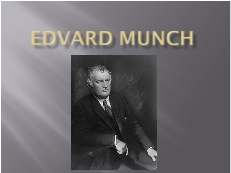
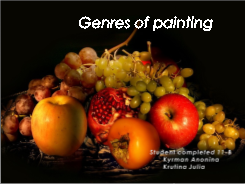
- The Main Part of the Lesson.
T: Painting is an important part of art. At our lesson we try to find answers to the questions: What is art? What is painting? What does it mean for you?
- Presentation of the topic.
- Speaking.
T: Today we are going to visit an exhibition. At our exhibition you can see paintings by French and Norwegian painters. Look at these pictures and choose the one which corresponds to your feelings. What emotions does arouse in you? Why does it fit your feelings?
(Teacher divides the class into three groups and gives pictures of Edvard Munch, Claude Monet, Edgar Degas and some material about)
(Students’ reports)
T: Look at the paintings once more. How can the atmosphere created by the painters be described? We can use adjectives, adverbs to describe it. And certainly music can help us. Listen to some short pieces of music; choose a picture corresponding to music. Why have you chosen this or that picture? (music of Chaikovskii, Motsart, Morua) After listening students choose the picture which is connected with the music and explain their choice.
- Reading. Page 205
Pre-Reading Activity (Using Internet site about Edvard Munch http://www.youtube.com/watch?v=r5uaB5MDe_8&feature=related)
T: Watch a short video about the picture of Edvard Munch “Scream”.
While-Reading Activity
T: Read what Edvard Munch said about his painting and say why he is said to belong to the style known as expressionism.
Post-Reading Activity
T: Pair up with the classmate who has the same preferences in art styles and discuss the merits of this style completing the dialogue. Use the expressions from pages 205-206.
A Talk on art styles
|
|
|
|
|
|
|
|
|
|
|
|
|
|
|
- Relaxation.
T: Let’s have some time to rest. Listen to the joke and try to understand.
After his wife divorced him, Joe asked his best friend, Bill, to fix him up with a blind date. Bill obliged. The next day Joe called up Bill and shouted at him angrily: "Bill, what kind of a guy do you think I am. That girl you fixed me up with was cross-eyed; she was almost bald; her nose was long, thin and crooked; she had hair growing on her face; she was flat chested; and her ankles were as thick as her thighs".
Bill answered: "Either you like Picasso, or you don't like Picasso."
- Listening. Ex.V, page 206-207
Pre-Listening Activity
T: Now we’ll listen to the information about one style of Ukrainian art. But what do you know about Ukrainian Art? Did you hear about the Petrykivka Style? After listening you will say why it is unique.
While-Listening Activity
Greater Reality
There are many phenomena of folk art in Ukrainian culture, which make this culture unique and original among other cultures of the world — Kosiv ceramics, rugs from Podillya, embroidered towels and shirts created in all parts of Ukraine are among them. A place of honour among these artistic phenomena is taken by paintings created in the village of Petrykivka, in the land of Dnipropetrovshchyna.
Styles of painting similar to that of Petrykivka were once called "magic realism" or even "the greater realism" (a term coined by the prominent non-figurative artist Wassily Kandinsky) and are part of what is usually called "primitive folk art," though there is nothing really primitive in this art. "Primitive" artists usually have no formal art education and they create without any constraints of the "academic" rules of art.
The Petrykivka style of painting is a very poetic view of the world around us, or rather it is a world in itself, a world which is free to interpret the usual things in a very unusual manner.
Tradition has it that Petrykivka was founded by a group of Ukrainian Cossacks in the eighteenth century and it so happened that soon after its foundation, the village, for some mysterious reasons, began to attract people with artistic gifts who came to settle down there. It is difficult, or almost impossible to tell now what the very first paintings created in Petrykivka looked like, but we can make an educated guess basing our conclusions on the surviving paintings of more recent times, and on the art of Petrykivka of today.
As a matter of fact, thanks to the watercolours painted by Yevhenia Evenbakh in 1911 and 1913, we have a pretty good idea what the Petrykivka decorative paintings looked like in earlier times. In the interior, the stove (or rather, pich, which in Ukrainian peasant houses served several purposes — for cooking food, for providing warmth in cold seasons, and for resting on it; the pich had a horizontal section like a large shelf, on which one could sleep), was particularly lavishly decorated.
Early decorative paintings in Petrykivka were mostly murals on the walls of the peasants' houses rather than easel paintings. The folk poetic interpretation of the surrounding world was and is at the basis of the Petrykivka paintings. Stylized flowers and guilder-rose are among the most popular motifs of the murals with even regular thistles and other weeds featuring rather prominently in the paintings.
In all likelihood, for a considerable length of time, paintings decorated only the walls before they began to be done on other materials — paper, wood panels or canvas. Mineral pigments were used for making paints and instead of brushes short lengths of reed stocks, twigs or even fingers were used to apply the paint onto the primed walls, the primer mostly being a thin layer of clay. Egg-based paints were used in later times to do paintings on paper.
Three colours were predominant — red, yellow (or yellow-green), and dark blue.
It would be wrong to assume that it was only in the village of Petrykivka that such painting flourished — decorative paintings of a very similar style could — and still can — be found in many other villages of Ukraine. The local styles differ in certain details but they all preserve a number of basic elements and features that makes it possible to recognise them as belonging to one and the same basic style, which was given the name of Petrykivka painting.
Post-Listening Activity
T: Now listen to the information again and correct the mistakes in the statements given.
- The Petrykivka style was originated in the south of Ukraine.
- This style was founded in the 19th century by a group of Ukrainian Cossacks.
- People with poetic gift settled down in Petrykivka.
- Early decorative paintings in Petrykivka were easel paintings.
- The folk poetic interpretation of the peasants' life was and is at the basis of the Petrykivka painting.
- Birds and animals are the most popular motifs of the paintings.
- The main colours of the Petrykivka style are red, orange and dark blue.
- The village of Petrykivka is the only place which is known for its paintings.
- The local styles of other places differ in basic elements.
-
The Conclusion of the Lesson.
- Homework.
T: Our excursion is over. And your homework will be: find more information about famous painters of our native land Olexandrivka. Share your information with your classmates.
- Summarizing. Marks.
T: Our lesson is over. What do you think about our today’s lesson? Did you enjoy something? What did you like to do at our lesson? At the end of the lesson we’ll see a presentation about famous Ukrainian painter which prepared Natasha.
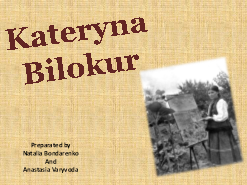

Lesson 4 Lesson with using the regional component
Topic: Famous Painters of Our District
Type of the Lesson: combined
Objectives:
Practical: to present and practise expressions, to practise intensive reading, to describe different genree and techniqes; to practise listening for specific information;
Educational: to enlarge students’ knowledge about local painters;
Developing: to develop students’ cognitive and creative skills; to bring up students to love art.
Equipment: a textbook form 10-th Kalinina L.V., Samoiliukevych I.V., interactive board, handouts, a computer presentation, projector, pictures of Victor Velychko, Tamara Gordova, Fedir Lagno, Victor Kirman, Nikolai Shmarko.
Lesson structure
- Introduction to the Lesson.
- Greeting and Aim.
T: Hello, dear children! First of all, I want you to remember our famous district painters.
- Warming up.
T: But first we’ll make a revision of our previous lesson. Look on the interrective board and watch the presentation about Petrykivka Style of Painting and our famous Ukrainian painter Tatyana Pata. Watch it and say your attitudes towards this style.
(Look the additional material: presentation #1).
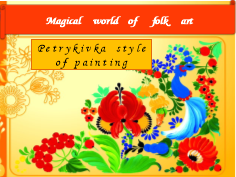
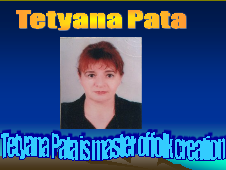
- The Main Part of the Lesson.
- Writing. An Art Style Revieew pages 207-208
- Pre-Writing Activity
T: An art style review is a report on an event or a period of time that mentions the most important art styles. How to write an art style review we will see in our books in exercise VI on page 207. So open your books and look through the useful phrases.
Content Tips
• Name the epoch (country);
• Give basic information about the time;
• Describe art styles popular in the epoch;
• Present the characteristic
features
of each style;
• Mention the most vivid representatives of each style.
Language Tips
— The time of... is known for...
— It is characterized by ...
— One of the most distinguishing eatures...
— ... is famous for...
— The most exciting ...
— Apart from this ...
— The paintings often show...
— The most common colour scheme ,
— The style ... became known as ... due to ...
— ... and other artists made this
style...
— ... manner of painting is ...
— I (do not) recommend you to ...
- Reading.
T: Read the sample of the art style review on page 208 and say if the author managed to reflect the tips.
Sample Art Style Review:
The 20th century is known for its abstract style of painting and the first painting of this style appeared in 1910. The style is characterized by the refusal of artists to depict the real world and the desire to create their own way of painting. The most exciting feature of all abstract paintings is the composition of lines, forms and colours. Apart from this, some representatives of this style added new themes for portraying and used their own symbols.
Wassily Kandinsky, Theo van Doesburg and other artists searched for individual, their own understanding of the world and tried to work out their own manners of painting, that's why there are many kinds of abstract art as cubism, abstractionism, expressionism, pop-art, etc.
T: So you have learnt how to write the art style review.
- Presentation of the topic.
- Check on Homework. Speaking.
T: Your homework was to find more information about famous painters of our native land Olexandrivka. Share your information with your classmates.
(Students’ answers, their presentation using the interractive board. Look the addinional material #2).

- Dialogues. Pair Work.
T: Millions of people during a year, across all social groups, attend museums and art galleries open to the public, which include the major collections of paintings as well as sculptures. Many museums and galleries are real treasure-houses of unique works of art. What are the well- known art museums and picture galleries? What collections do they contain?
Invite your partner to go to one of the museums or galleries. Find out how he\ she feels about it. Do not expect your partner to experience the same willingness to visit this place. Give really convincing arguments in favor of your choice. Use these words and expressions:
- I remember being charmed
- Prominent
- A real masterpiece of world painting
- I should say
- I am sure you won’t be disappointed
- The interior departments
- Fascinates the visitors
- Are on display
(Students’ dialogues)
с) Listening.
Pre-Listening Activity
T: Now you’ll listen to some information about our famous painter Victor Grigorovich Kirman.
- Do you know who Victor Grigorovich Kіrman is?
- Where was he born?
- What paintings does he paint?
Victor Grigorovich Kіrman was born in Ukraine the village Birky of Oleksandrivka district of Kirovohrad Region on February 24, 1963. He is an ethnographer, a scientist, a painter and Restorer, a member of the National Association of historians in Ukraine (2004), a Member of theUnion of artists of Russia (2001). He is a Deputy Head of the Union of Ukrainians in Rostov region. He graduated from the Rostov State Pedagogical Institute (now Southern Federal University) (1991). He works as the head teacher of the Art-graphic Faculty of the University (1991). He is the author of over 20 scientific works. He is a member of over 20 art exhibitions in Ukraine and in Russia. Some of the works are preserved in museums and private collections of Ukraine, Russia, Czech Republic, and Slovakia. Among the works of Kirman there are a number of paintins, which are connected with village nature. He restored the National Museum of history of Ukraine, Rostovs′kii regional Museum of area studies and the school Museum of the University, Oleksandrìvka district local historical museum and others. He promoted to replenish the funds Oleksandrìvka district local historical museum and organized several exhibitions. He is the author of articles in periodicals on the history of the village Bìrky, article "Bìrky’s people settled the seven thousand years ago" in the book of B. Kuzik and V. Bìloshapka "Oleksandrivs’kyi Meridian: People, Events, Time (2003)," on the material remains in the neighborhood ' times in the village of Bìrky, the possession of Hetman Bohdan Khmelnytsky "(co-author) in the collection of scientific articles" new study of Cossack Ukraine ". Issue 10 (2001), "the symbolism of the Cossack edge" in the collection of scientific articles "the witness of the Cossack glory: the view through the centuries" (2003), the article "The dating of the fragment of antique jug found near the village of Bovtishka Oleksandrìvka district of Kirovohrad region" to the collection of scientific articles "Oleksandrìvŝina. Past. Modern. The Future ". There are materials of Conference-presentation "(2008), several articles in the Collections of works Oleksandrìvka district local history museum.
While-Listening Activity
- Choose the words from the box to complete the sentences.
|
the author |
promoted |
the village |
connected |
an ethnographer |
- Victor Grigorovich Kіrman was born in Ukraine ___________Birky of Oleksandrivka district of Kirovohrad Region.
- He is _____________, a scientist, a painter and Restorer.
- He is ____________ of articles in periodicals on the history of the village Bìrky.
- He ____________to replenish the funds Oleksandrìvka district local historical museum and organized several exhibitions.
- Among the works of Kirman there are a number of paintins, which are ____________with village nature.
Post-Listening Activity
True, False or Don’t know?
- Victor Grigorovich Kіrman was born in Ukraine the village Birky of Oleksandrivka district of Kirovohrad Region on February 24, 1953.
- He is an ethnographer, a scientist, a painter and Restorer, a member of the National Association of historians in Ukraine (2004).
- He graduated from the Kyiv State Pedagogical Institute.
- He promoted to replenish the funds Oleksandrìvka district local historical museum and organized several exhibitions.
- There are materials of Conference-presentation "(2008), several articles in the Collections of works Oleksandrìvka district local history museum.
-
The Conclusion of the Lesson.
- Homework.
T: Our lesson is going to the end. And your homework will be: Write a review of your favourite art style.
- Summarizing. Marks.
T: Our lesson is over. What do you think about our today’s lesson? Did you enjoy something? What was the most interesting?
Lesson 5
Topic: Famous Painters and Their Pictures
Type of the Lesson: combined
Objectives:
Practical: to present and practise expressions, to practise students’ skills in reading, writing, speaking; to practise listening for specific information;
Educational: to enlarge students’ knowledge about English painters;
Developing: to develop students’ cognitive and creative skills; to bring up students to love art.
Equipment: a textbook form 10-th Kalinina L.V., Samoiliukevych I.V., interactive board, handouts, a computer presentation, projector, pictures of Thomas Gainsborough, Kateryna Bilokur, Ivan Aivazovsky, Ivan Shishkin, William Hogarth.
Lesson structure
- Introduction to the Lesson.
- Greeting and Aim.
T: Good morning, dear students. We’ll have a rather unusual lesson today because we are going not only to learn some new material on the topic but also try to be real specalists who know many things about Art. Now let’s answer the question: What is Art for you? But to answer the question we’ll read a short text.
- Reading.
T: Read a small extract below and answer the questions after it.
We can say that Art is everywhere! No matter how ordinary a thing might seem we can still call it exceptional by just realizing how nice and unique it is. Wonderful things surround us and those who cannot see them neglect the fact that they are wonderful by themselves. Everything starts with something. When an artist wants to paint he always thinks of a beginning. When a builder wants to construct he has to start with something. It is impossible to create wholesome things immediately as by a magic wand. The results can be different, and indeed they are! But that's the finest thing that could have happened to us. Imagine the world with millions Mona Lisas, thousands of Venuses and hundreds of Swan Lakes! What it would be like, to live in a world without a unique brilliance of masterpieces around us?!
- Speaking.
1) What is Art for you?
2) Have you got a certain criteria of what can be called a masterpiece?
3) Would you like to make a piece of art? Why/ not? What kind of it?
4) What piece of art impresses you mostly and why?
5) Have you ever thought of what is easier: to paint a picture, to build a palace, to compose a sonata, to write a poem, to model a sculpture, to sing opera, to operate a flying control system, to make an operation on the heart?
6) Can all of these examples be called 'art' or 'artistic' things? Why /why not?
- Writing.
T: Complete the description of a picture with the right prepositions.
This was probably painted___(in/ at) the eighteen century and shows people
___(in/ on) a bridge which is___(across/ over) a wide river. They are walking _
__(with/ by) their huge packages and sacks___(over/ on) their backs and it
seems like it's going to rain. They are going___(across/ over) the bridge___(to
and fro/ fro and to) unloading cargo___(from/ out of) a big ship___(with/ under) the Portuguese ensign. Looking at their faces we can see the hardships___
(in/ of) their lives and how much efforts they use not to fall.
- The Main Part of the Lesson.
- Check on Homework.
(Children read their review of their favourite art style.)
- Presentation of useful expressions.
T: Today we’ll describe pictures of famouse painters.
- Open your books on page 209 and look useful expressions for our speaking. They will help us when we describe pictures.
Academic English
• genre of painting
• landscape
• seascape
• portrait
• still life
• unsurpassed masterpiece
• blend of light and shade
• shades and hues
• to take up art
• to paint from nature
• colour scheme
• pretence of art
Conversational English
to evoke feelings
to pore over sth
to absorb sth
to make sb gasp
to stand the test of time
parable
a real breath of fresh air
to stretch out longer
to leave sb breathless
You have a point here, but
• colourless daub of painting
- Make up 2-3 sentences with these expressions.
3. Speaking.
T: Look at the pictures and say which genre of painting you like most and why. Look at these pictures and choose the one which corresponds to your feelings. What emotions does arouse in you? Why does it fit your feelings?
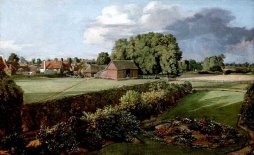
landscape - John Constable
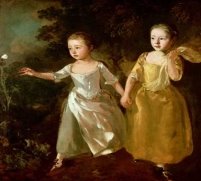
Portrait painting - Thomas Gainsborough
Painter’s daughters
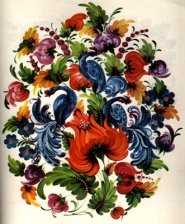
The “Petrykivka Style of Painting” - Tetyana Pata
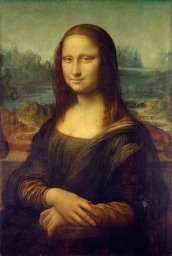
Portrait painting – “Mona Lisa” Leonardo da Vinci
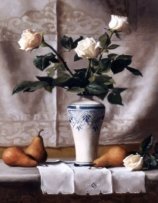
Still life
4. Reading.
a) Pre-Reading Activity
T: Before reading the poem “Mona Lisa” we’ll watch a presantation about her and the author of this unsurpassed masterpiece. (One of the students shows the presentation using the interractive board.)
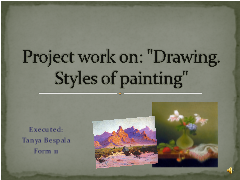
- While-Reading Activity
T: Read the poem "Mona Lisa" exercise II, pages 210-211 by Brenda M. Weber and practise the intonation of yes / no questions.
Mona Lisa
'Behind 'kaleidoscopic eyes
There's no'mystery 'there that lies
'She's the 'one to 'see it 'all
from her 'position on a wall.
We 'look for 'something in her^mile,
We 'stand to 'study her ^awhile
Her 'face of 'beauty that we seek.
'What would she^say if 'she could speak?
Is her 'beauty oh so^rare?
Was 'Mona just a ‘maiden fair?
Is she a 'mirror 'image of ^me?
Is that 'what I'm 'supposed to^see?
'Mona's 'portrait on the^wall —
A'combination of us all.
There's a 'touch of 'someone^there
in the 'beauty of her hair.
That 'hint of 'prism in her^eyes
'makes her 'appear to be so wise.
The 'playful 'curvature of her^lip,
On her 'cheeks can 'dance a quip.
She's a beauty, this 'Mona Lisa
but so is the 'Leaning 'Tower of Pisa.
'What is the 'mystery there that lies
Behind 'kaleidoscopic eyes?
By Brenda M. Weber
- Post-Reading Activity
T: Say why the author finds the portrait so mysterious. Do you share the opinion?
- Reading. Enrich yourself!
- T: Watch the presentation about William Hogarth and try to remember key facts about him. (One of the students shows the presentation using the interractive board.)

- T: Look at William Hogarth's masterpiece "The Shrimp Girl", read what an art critic wrote about it and say if the picture produces a similar effect on you. How, in your opinion, is it achieved? (Page 214).
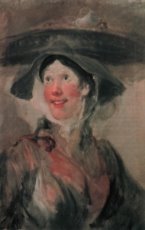
William Hogarth “The Shrimp Girl”
A Picture Review
Portrait painting is one of the glories of English art. William Hogarth, a curious observer of men and manners, gave the decisive impetus to the national temperament. "The Shrimp Girl" is an unsurpassed masterpiece, depicted in bright colours and quick brush strokes. The image of a laughing, cheerful common girl is contrasted to the ugly world of vices and corruption. In this portrait, the artist managed to capture the girl's expression and the mood of the moment. Her face and everything in the picture is young and fresh. Simple and real-life atmosphere, illuminated by youth, is joyous and lovely.
- Read an overview of English painting and complete it with the phrases from the box.
|
English portrait school geniuses greatly influenced National school of painting imitators and successors innovators forerunners of impressionists supreme heights |
An Overview of English Painting
Painting in England in the 17th-19th centuries is represented by a number of great artists, and during that period it was greatly influenced by foreign painters. The Flemish painter Anthony van Dyck (1599-1641) was really the father of ... . Though he trained a few English pupils, his principal ... were like he himself foreigners settled in London. Only during the 18th century a ... was founded in England.
For rather more than a century, England was to see a brilliant succession of ...: Reynolds, Gainsborough, Lawrence, Constable and Turner. Two genres — portraits and landscapes — rose to... . English landscapists' great love for their countryside, and their ability to paint it made them ... in this field. Gainsborough and Constable are sometimes considered to be the ... .
- The Conclusion of the Lesson.
- Homework.
T: Our lesson is over. You have become little specialists in Art. And your homework will be: you will be divided into three groups: the first group will find more information about the National Gallery in London, the second group – about the National Art Museum of Ukraine in Kyiv, the third group will think that art is not very important for their lives.
- Summarizing. Marks.
T: Did you like our lesson today? Was the information of the texts interesting for you? What new information have you learned from the projects? Which project did you like most of all? Why?
Lesson 6
Topic: Going to the Famous Museums
Type of the Lesson: General Lesson, combined
Objectives:
Practical: to present information about famous museums, to practise students’ skills in discussing problem questions on the topic, reading, writing, speaking; to practise listening for specific information;
Educational: to enrich students’ knowledge about famous museums;
Developing: to develop students’ skills in group work; to bring up students’ patriotic feelings and pride towards their Motherland showing the great contribution of Ukrainian Art into the world culture.
Equipment: a textbook form 10-th Kalinina L.V., Samoiliukevych I.V., interactive board, handouts, a computer presentation, projector, Internet, presentations about world museums.
Lesson structure
- Introduction to the Lesson.
- Greeting and Aim.
T: Good morning, dear students. We’ll have a rather unusual lesson today again because we are going to visit well known museums.
- Warming up.
T: Read the questions below to start a conversation with your partner.
1) Have you got any pictures on your walls at home? If so, did you choose them? Do you like them?
2) How important is art in your life?
3) Do you enjoy visiting art galleries? Why/ not?
4) Do you think art galleries and museums should be free for people? Explain your answer.
5) Do you think children should obligatory do painting at school? Why/ not?
6) Do you like abstract art or you prefer to see clearly what a painting or a sculpture is of?
7) Who is your favorite artist? What is your most beloved painting or sculpture?
- The Main Part of the Lesson.
1. Introduction of the groups of pupils at the lesson.
T: We are happy to live in such a country as Ukraine, which occupies one of fhe leading places in the world culture. The main treasures of Ukrainian seascape painting are represented in the Aivazovsky Picture Gallery in Feodosia. But on the other hand since we study the English language and we must be aware of the culture and traditions of Great Britain if we want to master the language perfectly. And the most famous and well-known picture gallery in London is the National Gallery. So, today we have three groups of students: the 1st group studied everything about the Aivazovsky Picture Gallery; the 2nd group learned information about the National Gallery; the 3rd group of students thinks that art is not very important for their lives. So, our task at the lesson today is to make the third group change their opinion about art and involve them in our discussion.
- Exchanging information about the best picture galleries of Feodosia and London.
(One of the students shows her presentation about the Aivazovsky Picture Gallery)
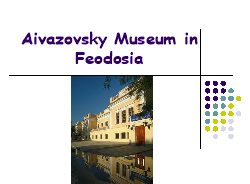
T: Now you are going to listen to a dialogue between the students from Ukraine and Britain discussing art. Listen attentively and make notes about the main picture galleries. The ideas on the list will help you.
(The teacher gives out sheets of paper to record the information.)
The Dialogue about the Two Galleries
Pupil 1: Hello, Vadym! I’m here on holidays. Can you advise me what to see in your city?
Pupil 2: Hello! Glad to meet you. Please, tell me what are you interested in?
Pupil 1: I’m fond of seascape painting.
Pupil 2: Lucky you are. I share your interests and can advise you to visit the Aivazovsky Picture Gallery.
Pupil 1: It’s a picture gallery, isn’t it? Why is it called the Aivazovsky Picture Gallery?
Pupil 2: It was named in honour of its founder, the great painter and philanthropist, Ivan Aivazovsky. The Gallery in fact is the sole in Ukraine museum of the seascape painting. His life and creative career is reflected by the exhibition of the memorial-historical department.
Pupil 1: How old is the Gallery?
Pupil 2: The Gallery was founded in 1880 by him.
Pupil 1: Why did he settle in Feodosia?
Pupil 2: In 1845 the painter settled in Feodosia because of his deep affection for the Black Sea and his native city. He took the most active part in the life of the city. I. Aivazovsky wanted to make his house a center of artistic life. In 1880 to the house where he lived became one of the first picture galleries in the country. Ivan Aivazovsky worked till his last day. His woreds “To live means for me to work” could be his motto. But I wonder what the most famous picture gallery is in your country.
Pupil 1: Don’t you know? It’s the well-known National Gallery in London.
Pupil 2: Was it based on a Royal collection?
Pupil 1: No, it was based on a private collection of the Russian emigree banker John Julius Anderstein. At that time the collection had only 38paintings and it was put on public display at Anderstein’s old residence.
Pupil 2: Where is the Gallery situated now?
Pupil 1: It is situated on the north side of Trafalgar Square. If you stand with your back to Nelson’s Column, you will see a wide horizontal front in classical style. And what does the Aivazovsky Picture Gallery look like?
Pupil 2: Aivazovsky Art Gallery is one of the oldest art museums. The building of the gallery is the monument of architecture of XIX century. The architectural and decorative design of the house built in the Renaissance style of Italian villas. At the main facade of the artist’s house is placed the bronze statue on a pedestal with the laconic inscription: “Feodosia for Aivazovsky”. This was the first in Russia peripheral art gallery, being very famous during the lifetime of marine painter. Also it was the first museum of one artist on the territory of Russia Empire.
Pupil 1: Is the collection of your gallery rich?
Pupil 2: Yes, very. Now the museum has more than 8 thousand items of the main fund. Here are collected the largest collection of I. K. Aivazovsky, works of K. F. Bogaevsky, M. P. Latri, V. Surikov, A. Kuindzhi, M. A. Voloshin and other artists, including old West-European masters. But the main treasure of the museum is the collection of paintings and graphic works of I. K. Aivazovsky, which has about 416 works. It presents all the periods of the artist's work. To the best canvases belong "Bay of Naples in the moonlit night" (1842), "The Sea" (1853), "Storm in the North Sea" (1865), "Sunny Day" (1884), "Among the Waves" (1898) and other. In the first exhibit halls are presented the pictures of the great marine painter, namely, the main part of the exhibition represents all the periods of creativity of Aivazovsky, from student works and to his latest paintings. Paintings are exhibited also in the studio of Aivazovsky, his office, living room. The following halls display the works of his disciples, contemporaries and followers, who continue the picturesque traditions of the marine painter. The gallery also contains more than 500 works by Aivazovsky grandson - M. Latri. And what about your Gallery?
Pupil 1: You know the National Gallery in London is the principal British art gallery and one of the world’s greatest art collections. It is situated on the north side of Trafalgar Square. If you stand with your back to Nelson’s Column, you will see a wide horizontal front in a classical style. It is the National Gallery. Unlike the Louvre or the Hermitage, the National Gallery is not based on a former royal collection, but it was founded in 1824 by a Russian emigree banker, John Julius Anderstein. At that time the collection had only 38 paintings and it was put on public display at Anderstein’s old residence at 100 Pall Mall. Another source of information says that 38 paintings of Old Masters were offered to the nation by an English private collector, Sir George Beaumount.
In 1838 the present building was built especially for the National Gallery by the Greek architect William Wilkins.
The Gallery is one the youngest collections in Europe but it has more than 2,200 paintings. The National Portrait Gallery has more than 9,000 portraits of distinguished men and women of British history. The National Gallery exhibits works of all the European schools of painting which existed between the 13th and 19th centuries. The collection includes Italian masterpieces of Pierro della Francesca, Leonardo da Vinci, Raphael, Botticelli, Michelangelo, Caravaggio, Titian, Paolo Veronese. You can see paintings of Velasquez, El Greco, Goya from Spain. There are also masterpieces of Dutch artists, such as Rubens and Rembrandt. You can also find paintings of famous Impressionists. British art is also represented with important works by Turner, Gainsborough, Hogarth, and Constable.
3. Work on the history of the museums.
The teachers ask questions:
1. When was the Aivazovsky/National Gallery founded?
2. Where is the Aivazovsky/National Gallery situated?
3. What architectural style does the Aivazovsky/National Gallery represent?
4. Who was the founder of the Aivazovsky/National Gallery?
5. How many paintings are there in the Aivazovsky/National Gallery nowadays?
6. Artists of what countries are represented in the Aivazovsky/National Gallery?
7. What places do these Galleries occupy in world history?
|
The National Gallery |
The Main Information |
The Aivazovsky Gallery |
|
|
The date of foundation |
|
4. A talk on the “Golden Age” of Russian and English painting.
T: Now we see that you have learnt much about the most famous galleries of Ukraine and London. But today we’d like to direct your attention to the painting of the “Golden Age”. In Great Britain the period between 1730’s and 1830’s is considered to be the “Golden Age”. At that time many first-class English masters contributed much to the history of world art. They were Thomas Gainsborough, John Constable and William Turner.
(Some of the students have prepared short reports about the most outstanding artists and paintings of both countries: Aivazovsky, Constable, Gainsborough, Hogarth, Turner,)
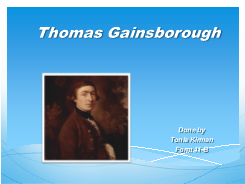
http://www.youtube.com/watch?v=wnRoZexad4Q&feature=related
(Gainsborough)
http://www.youtube.com/watch?v=Zc_zrz6j9Hw&feature=related (Turner)
http://www.geocities.com/uttamkumar44/video_clips2.html (Turner)
5. Teaching the students to make up dialogues discussing paintings.
T: While visiting any picture exhibition you want to share your impressions and opinions with your friends. One of the groups considers that art is not very important. Let’s listen to them.
P1: For me arts education isn’t very important at all. I get my credits from my Architecture class which to me is a good thing. I personally hate art classes. I don’t like a teacher telling me to tweak this or change that or start over. I can do that myself. And anyways isn’t it YOUR art work not theirs? All art programs to me aren’t that special and I don’t really like them. For my school you need like two art credits to graduate and I don’t find that right. Art should be if you want to do it. Not cause you have to. All in all I dislike art.
P2: I dont think it’s important at all because…we don’t need art to be successful in life unless yhu wanna be an art teacher.
P3: Arts Education isn’t that important in my life because I plan on furthering my education by studing business. Arts lets a student be creative and all but that’s not for me.
P4: I really wanted to understand art and why it is important. Unfortunatly the more I studied art the more bitter the sour taste in my mouth got. I don’t want to sound disrespectful as this is only my opinion but I just don’t see the point. It’s a pretty picture that looks nice. That is all. It is not a masterpiece that is worth millions of pounds. The fact that there are huge numbers of people that are willing to spend millions on paint is vulgar and disgusting when there are so many hungry people living in refugee camps around the world. I could understand two people competing to buy a painting they both loved, but with printing technology available to produce near perfect copies why bother when they could both have the painting above their mantle piece. Nobody is bothered about having the first copy of films or music so why is a painting any different.
Some people don’t like to eat steak, that’s there personal preference and their entitled to it. Just because art has been around for thousands of years doesn’t make it important, trees have been around for much longer but nobody pays millions for trees even though we would all die without them.
500 years ago nearly everybody said the world is flat. Just because lots of people say that art is important doesn’t mean it’s true. I think it’s a conspiracy as most expensive paintings are locked away in vaults with nobody enjoying there beauty. If the whole world decided they didn’t like gold any more it would be as worthless as mud. Organisations and people with expense paintings therefore must use intellectual propaganda to make their art assets worth more. If university students all stopped studying van gough and Picasso there paintings value would fall drastically. They lure young artists in with the promise that if you play by our rules you can maybe one day sell you painting for a fortune and be rich. Artists don’t do it for love or to express emotional turmoil, they would just love to sell there paintings for $130 million like Jackson Pollock.
I think it’s an amazing capitalist plan to make money from nothing; art does nothing you just look at it that is all.
- Debates.
T: What is your opinion?
P5: Arts education is one of the most important classes in school. Everyone gets to be themselves through the arts. Students learn to be unique and creative. Math, English, History, and core classes do not allow anyone to be themselves. The arts help students to find out who they want to be, and find out who they are.
P6: I totally think art’s important! It gives kids a chance to be creatie. Pottery, music drama,…personally are so much better than , for an example, ‘architecture’ , because art isn’t labeled. It’s creative. It’s YOU.
P7: Art plays an important role in my life. It aids the people`s understanding of their culture. No doubt tastes should be developed through images of high artistic culture, whereas works of popular culture as a rule meet consumer`s tastes.
P8: In my opinion the habit of looking at good pictures is in itself a means by which taste can be formed. Art allows people to talk about emotionally meaningful experiences. Every artist tries to develop his own style of painting to differ from other ones. There are many styles of painting in art: a portrait, a still life, a landscape, a seascape and etc. An artist has the skill to combine form and colour into harmonious entity and to represent a brilliant colour scheme. The artist`s pictures may be dull, crude, chaotic and colourless daub of paint. But in spite of it they are an exquisite piece of painting.
- Dialogue.
T: Now let’s try to read some dialogue.
(Pupils read the short dialogue in pairs.)
Teach: I hope that you understand all the words and expressions from these dialogues very well. When you discuss a picture you will need some other words and phrases, which you have already learnt. Let’s revise them. Give some synonyms to the following: a painter; a picture; to draw; colours; schools; school of painting; How can a picture be drawn? What can canvases represent? How can pictures convey the ideas and things represented?
Memorise this Short Dialogue
T: Now we’d like to present a dialogue discussing a picture.
(The teachers present a dialogue on the painting by W. Turner “Rain, Steam and Speed”.)
– Dear Galina, I’d like to turn your attention to my favourite painting.
– Whom was the picture painted by?
– It was made by a famous English artist, William Turner. It was painted in the 18th century.
– But I shouldn’t call it a picture at all. To my mind it is a blur. It is a mere spattering of colours!
– But wait! Look attentively! This is a very rainy day, so rainy that it is difficult to see. And the wind is blowing, too. At first glance we can see very little, but then we notice a steam train which speeds along its journey. The train is on the bridge and down below there is the river Thames.
– Oh, what’s there in the distance? I can’t make out anything!
– I think it’s a small boat, sailing on the water. Where do you think... where is it safer: on the boat in such stormy weather or in the train with the windows closed?
– I’d prefer to be in the train!
– Right you are. William Turner lived at the beginning of the age of steam. He often painted subjects showing the impact of the Industrial Revolution upon his country.
– Oh, now I see. First I thought that it was completely meaningless. Now I realize that you can understand the picture better if you know something about the painter himself and his time.
– Of course. That was just what I wanted to say! From my point of view it’s an impressive piece of art. Just look, the effect of light is striking.
– Yes, it’s amazing. And I should call this kind of art thought-provoking, because it makes us think.
T: Now try to make up your own dialogues about famous pictures. Use words and phrases from the book on page 221 and on the board, give your opinions.
Negative Impressions
The drawing is full of faults.
The perspective lacks depth.
Light is not rendered at all.
It isn’t a picture; it is a mere spattering of colours.
The painting is a blur. One can hardly make out anything.
I shouldn’t call it a painting at all.
It offends the eye.
It’s too bad for words.
It’s completely meaningless.
I was shocked by...
It’s a shame...
No good at all!
It’s unbelievable trash.
It’s beneath all criticism.
It’s ridiculous, disgusting.
Positive Impressions
I am favourably impressed by the picture.
It is realistic and true to life.
It is thought-provoking art.
It is an honest presentation of...
There is convincing truth in this painting.
This is what I should call true realism!
Isn’t it superb!
It’s quite a find, isn’t it?
Oh, but do look at this portrait! It’s a work of genius.
The effect of the light is striking.
It is magnificent (lovely, amazing, fantastic).
I’m absolutely thrilled.
It’s an impressive piece of art.
It’s too divine for words.
It conveys its meaning absolutely.
General Discussion
May I put a word in?
If you ask me...
It just occurred to me...
Generally speaking...
Strictly speaking...
That depends on...
I want to press the point that...
On one hand...
On the other hand...
Under the circumstances.
As far as I’m able to judge...
From my point of view...
To sum it all up...
All things considered…
We can arrive at the conclusion that...
I’d like to make some brief comments about...
On the whole...
To be brief/ in a word...
In short...
All these show conclusively that...
The students prepare and present their dialogues and describe their favourite picture.
- The Conclusion of the Lesson.
- Homework.
T: Our lesson is over. You have learnt a lot of information about museums, famous painters. We understand quite clearly that there are lots of things that can be defined as art. Can you think of at lest ten things that surround you in your everyday life and are as good as to be called pieces of art? Explain your choice and opinion.
- Summarizing. Marks.
T: I suppose no one is born an art lover, but you can become one. I hope that lessons devoted to art widened your scope and enriched your knowledge and understanding of the world of beauty. The world of art will change something in your souls for the better. I’d like to thank you for your good work at the lesson.
T: We have some time and we can watch another presentation about the National Art Museum of Ukraine.
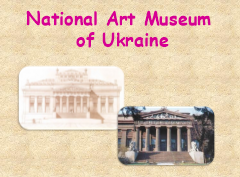


про публікацію авторської розробки
Додати розробку

